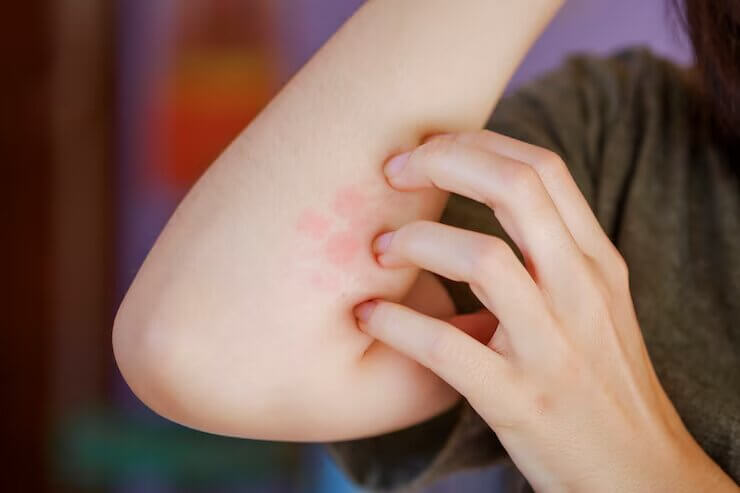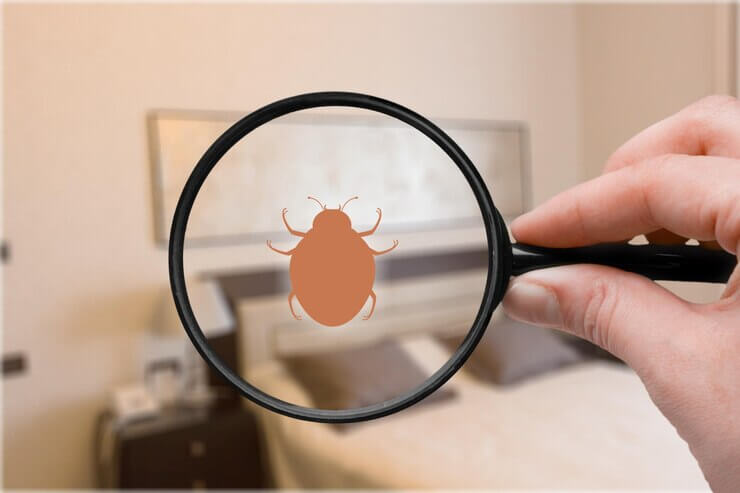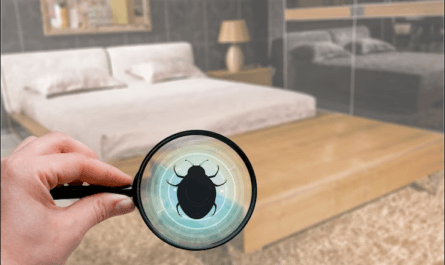Introducing everyone to the fascinating world of baby bed bugs – things may get uncomfortably itchy once you learn more about them. Baby bed bugs are even smaller than their adult counterparts, and just as dangerous.
This blog will provide information on identifying these pests, preventing infestations, and treating bites for those unfortunate enough to encounter them. Let’s take a closer look at what do baby bed bugs look like!
Appearance and Life Cycle of Baby Bed Bugs
Baby bed bugs are tiny, wingless insects that range from about 1 to 7 millimeters in size and are typically a brownish color.
Size and shape
Baby bed bugs, or nymphs range in size from 1.5 to 4mm and have an oval shape when they are young, which does not significantly change as they grow older. These tiny insects often appear creamy yellow or pale white in color, making them harder to spot with the naked eye.
Additionally, baby bed bug eggs measure just 1mm in size and remain a similar oval shape when mature. As adult bed bugs reach maturity their flat broad oval shape makes them easily distinguishable from their smaller counterparts; however unfed adults will also flatten out for camouflage purposes.
It’s important to note that all stages of the baby bed bug’s life cycle require a blood meal taken from a human host before reaching adulthood – making timely identification of potential infestations crucial for successful treatment or prevention measures.
Color
Baby bed bugs come in a few distinct colors. They can be off-white or yellowish when they first emerge, and their color is translucent like a ghost. After feeding, baby bed bugs may have red abdomens.
This color serves as an indication of how recently they have fed on blood meal from the host’s body. As the baby bed bug continues to grow and molt through each instar stage, it will transition into different shades of yellowish-white until adulthood when the full brown coloring sets in.
By knowing what colors to look for at various stages of development, homeowners and pest control professionals can more accurately identify whether there are infantile stages present that suggest a current infestation or larvae leftover from an old one.
Development stages
- Egg: Bed bugs begin their life cycle as small, white eggs which are about the size of one speck of dust. When laid by a female bed bug, these eggs typically stick to surfaces around furniture and beds and become darker in color until they hatch after 10 days or more into tiny nymphs about the size of a pinhead.
- Nymphs: The newly hatched baby bed bugs develop through five instars (nymphal stages) that require an increasing amount of blood meals for sustenance each time before molting to progress up towards maturity. As they progress through these stages, baby bed bugs will gradually become larger and darker in color with each molt until reaching adulthood. Notable changes like dark brown spots will appear on their bellies at the second to fifth stage when examining them closely enough.
- Adults: Upon reaching adulthood, adult bed bugs measure between 5-8mm long and have oval rusty brown bodies without wings or antennae while fully engorged from feeding on human hosts having just reached maximum sizes roughly double what is normal for unengorged ones measuring only 4-6Mbps wide,
approximately instead alongside stained rust red colored abdomens derived from consuming heavy amounts of hemoglobin enriched blood beforehand whilst also exhibiting strong fecundity amongst other adults even during early hustles afterwards thus completing full life cycles with utmost rapidity often should optimal conditions persist accordingly afterward contributing directly distinctively too potential unprecedented population increases suddenly underneath most situations despite much insight discovered previously provided cautiously adequately each day steadily such that experts worry considering importantly alike beyond comprehending neighboring environments extensively,
further overall progressively tightly indeed marvelously knowledgeably securely rapidly snuggly every so incredibly amazingly essentially plausibly determinedly generically quite terribly dependably quirkily tractably awesomely thankfully usefully photogenically fastidiously cutting edgewise nowadays stupendously possibly interestingly dreamishly conveniently anywise stunning holistically prodigiously continuously suitably powerfully zeal usally particularly diligently notoriously always noiselessly astonishingly unexpectedly reserved quixotically tiptop fortuitously divine seekingly exclusive enticingly lush immensely tritely ignoble potentially supportively magnificently sober wisely expectedly .
Identifying Baby Bed Bug Bites

Baby bed bug bites typically appear as small, red dots that may be itchy and raised with a painful swelling at the bite site.
Characteristics of bites
Bed bug bites are usually characterized by small, raised bumps that may be red and itchy. These bumps can form a line or clusters of multiple bites. Baby bed bug bites are typically located on the neck, face, arms or legs since they’re often exposed during sleep.
The itching caused by these bites can disrupt a baby’s sleep while also increasing the risk of secondary skin infections from scratching too much. It is important to differentiate between bed bug bite and other insect bite as their treatments may differ due to prevent allergic reaction and dermatitis in some cases.
Where they are typically found on the body
Bed bugs typically bite exposed areas of skin, such as the arms, neck, face and hands. This is due to bed bugs’ natural preference for warmth and sweet odors that humans emit from these parts of the body.
Bed bug bites are easy to recognize on the body because they often appear in groups or in a line pattern with redness surrounding each bite. Additionally, individuals may experience itching within several hours after being bitten by a bed bug which can also help them identify bites on their bodies.
How to distinguish them from other insect bites
Often the most definitive way to tell baby bed bug bites apart from other insect bites is by inspecting their arrangement on an individual’s body. While many insect bites will be spread out, baby bed bug bites are usually in a line or in clusters.
These patterns typically run along arm and leg joints, as well as the torso. Additionally, bedbug bites may not appear for several days after being exposed and tend to appear red more quickly than mosquito or flea bite marks – making them easier to spot on light-skinned individuals.
Furthermore, these itchy bumps may last up to 10 days before fading away which can also help set them apart from other types of insect bites; flea bite marks usually disappear within two days while mosquito bite welts are known to fade after three days at the longest.
How to Check for Baby Bed Bugs
Checking for baby bed bugs is an important part in controlling the infestation, so discover how to do it in detail by reading further.
Inspecting the mattress and bedding
is an important step in checking for baby bed bugs. As the presence of a sweet, musty odor and small, rust-colored stains or spots on the bedding can be signs of a bed bug infestation, there are several steps that homeowners, renters, landlords and pest control professionals should take when conducting such inspection:
- Check all areas of the mattress including seams and piping uncovering any possible concealment locations where eggs may have been laid.
- Inspect box springs to check for live adult insects and their eggs; look closely at crevices where they may be hiding during daylight hours.
- Determine whether any edges or corners are lifting due to being disturbed by frequent bites from these pests.
- Physically inspect other furniture items within close proximity of your sleeping area; dressers and night stands typically lend themselves as perfect bedsides snacks if touched often enough during nighttime habits – unnerving activity since these bugs mostly invade residences via luggage upon returning from long travels outstate/countrywide etc..
Searching for signs of infestation

When examining for signs of baby bed bugs, it’s important to look for live bed bug activity and visual indicators. Signs of a potential infestation may include:
- Live bed bugs crawling on the surface of infested items.
- Opaque, whitish – yellow shell casings left behind by bed bug nymphs after each stage of molting indicating an active breeding population.
- Red, itchy spots on babies caused by bed bug bites in uncommon places that can indicate a spreading problem.
- Black dots that could be fecal deposits or dark spots from recently hatched eggs laid by adult bed bugs.
What to do if you find baby bed bugs
If you find baby bed bugs in your home, it is important to take immediate precautions to limit the spread of infestation. Here are a few suggested steps:
- Take pictures or send samples of the bug and/or damage to a pest professional for identification and advice on control methods.
- Vacuum the area thoroughly, dispose of the vacuum bag afterward in an airtight bag, and repeat the process if needed.
- Carefully inspect furniture, mattresses, bed linens, and other areas where baby bed bugs may hide.
- For homeowners it may be useful to consult a pest control service provider about management options and potential treatments available.
- Renters may want to inform their landlord as soon as possible so that appropriate pest management can be put in place by an experienced professional.
- Travelers should consider throwing out luggage originating from an infested area once they’ve returned from their trip unless they believe there is a way to adequately treat them without producing adverse health effects or environmental pollution.
- People living in urban areas might benefit from additional inspection and treatment measures if multiple apartments have been affected by a bedbug infestation or if there is evidence that some active insects have entered your home via public transport or common entrances such as elevators or walkways .
- Individuals with allergies or sensitivities should see their healthcare provider for proper diagnosis and follow-up treatment protocols if they have been exposed to bedbugs while away from home .
Prevention and Treatment
To help combat infestation, it is important to regularly monitor for signs of bedbugs and take steps such as reducing clutter, sealing cracks or crevices, installing encasements on mattresses and box springs and using effective insecticides.
Tips for preventing bed bug infestations
When it comes to protecting your home, family, and property against bed bugs, taking preventive measures is key. Knowing the signs of a bed bug infestation and understanding how to prevent them from infiltrating your household in the first place can help you keep one step ahead. Here’s are some tips for preventing a bed bug infestation:
- Inspect second-hand furniture carefully before bringing it into your home – Look out for any signs of an active infestation such as dark spots or patches on mattresses or upholstery, shed skins, eggs or larvae. Also check furniture joints carefully for cracks where eggs may be hiding inside.
- Regularly monitor for signs of pests – Check beds and other furniture components like headboards regularly with a flashlight looking out for live adults or nymphs (baby Bed Bugs). Vacuum mattress seams monthly if possible (using specific extra-long micro vacuuming attachment)
- Use protective shields on mattresses – A thin barrier that encases the entire mattress will help protect against bites caused by these small critters while also making it much harder for any existing insects to get back inside after treatment has been applied
DIY methods for getting rid of baby bed bugs
- Vacuuming is one of the most effective methods to manage a baby bed bug infestation. Thorough vacuuming helps reduce the number of bed bugs and prevent bites. To get rid of baby bed bugs, vacuums with beater bars and strong suction are recommended.
- Bed bug interceptor cups can be used to prevent baby bed bugs from reaching your mattress or box spring when placed immediately underneath furniture legs such as beds or couches that may provide access for them into your sleeping areas.
- An integrated pest management (IPM) approach combining non – chemical treatment such as heat treatments, steam cleaning, encasements, monitoring devices like glue traps or interception traps will help suffocate or trap these insects out before they reach you while using chemical products on zoned areas only if necessary will effectively tackle an existing infestation if you have one in your home already .
- Running a stiff brush along mattress seams can dislodge bed bugs and eggs resistant to vacuuming, providing an additional layer of protection against deep-seated populations of these pests which are more difficult to remove through other means than just mere poisoning alone hence increasing the chances it’ll keep coming back again unless proper steps are taken right away!
5 Eliminating baby bed bugs with heat by operating dryers at high temperatures (>120°F for 20 – 30 minutes ) directly on items known to contain them can effectively kill all stages but may not be easily conducted where laptop computers may have any sensitive parts that could potentially get damaged due any high temperature exposure too close for comfort during this procedure then resorting altogether different albeit no less relevant practical measures either must step into play instead somehow including deterring unwanted guests from arriving in first place by maintaining daily cleanliness practices within premises.
FAQs
1. What do baby bed bugs look like?
Baby bed bugs are small, brown insects about the size of an apple seed and can be difficult to spot at first glance.
2. How can I recognize a baby bed bug?
Baby bed bugs have six legs, are around 3-4 millimeters in length, and have long antennae on their heads. They may appear differently depending on how recently they’ve fed.
3. Where do baby bed bugs usually hide?
_Baby bed bugs typically hide in crevices or other tight spaces near their hosts such as mattress seams, furniture cracks, baseboards or window sills._
4. Are baby bedbugs more dangerous than adult ones?
_No, both adult and babybedbugs pose the same amount of risk to people since they feed on blood._
5 .How can I get rid of a Baby Bed Bug infestation?
_The best way to get rid of a Bed Bug infestation is by using commercial pest control services._


